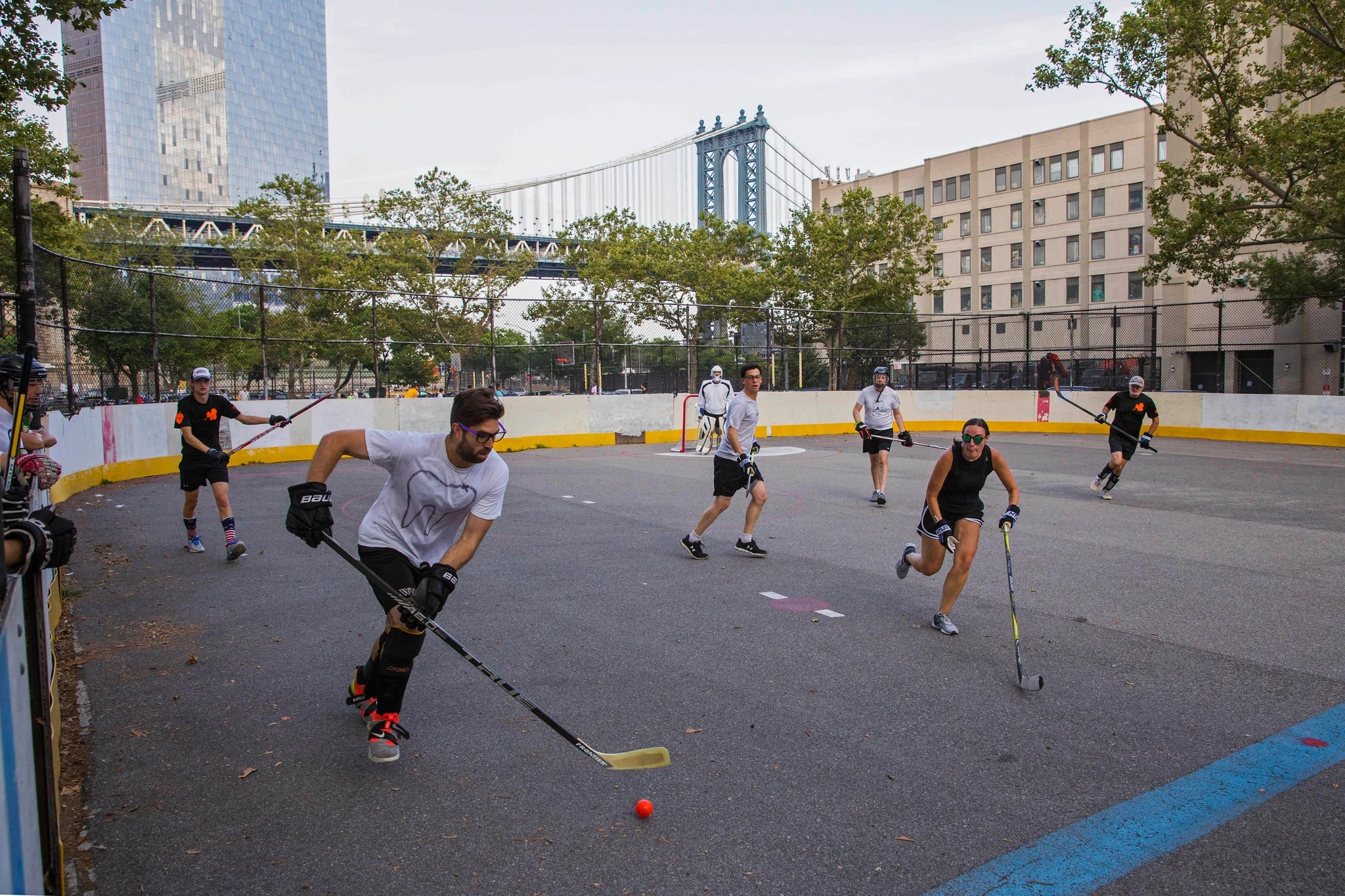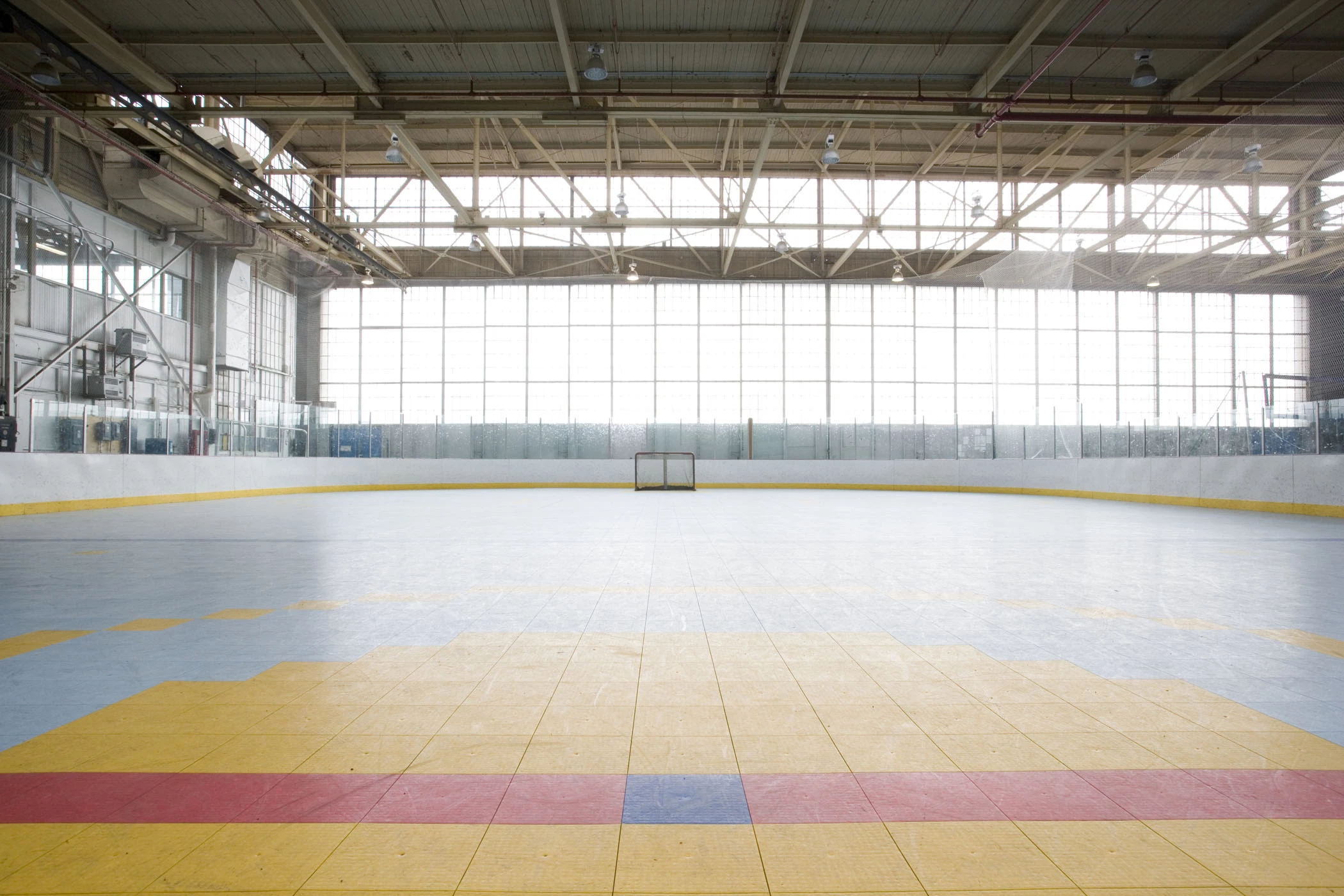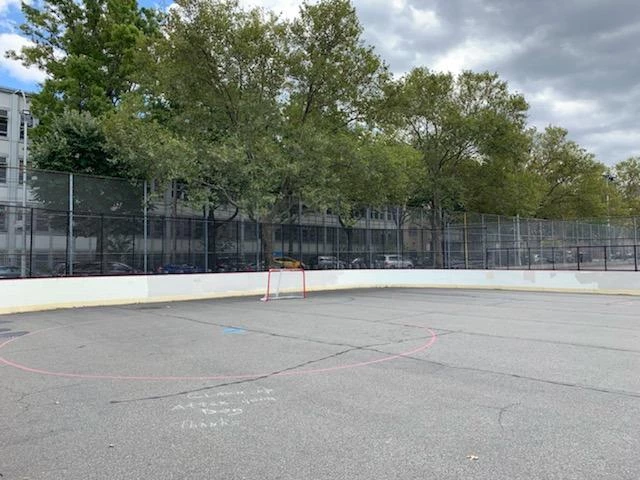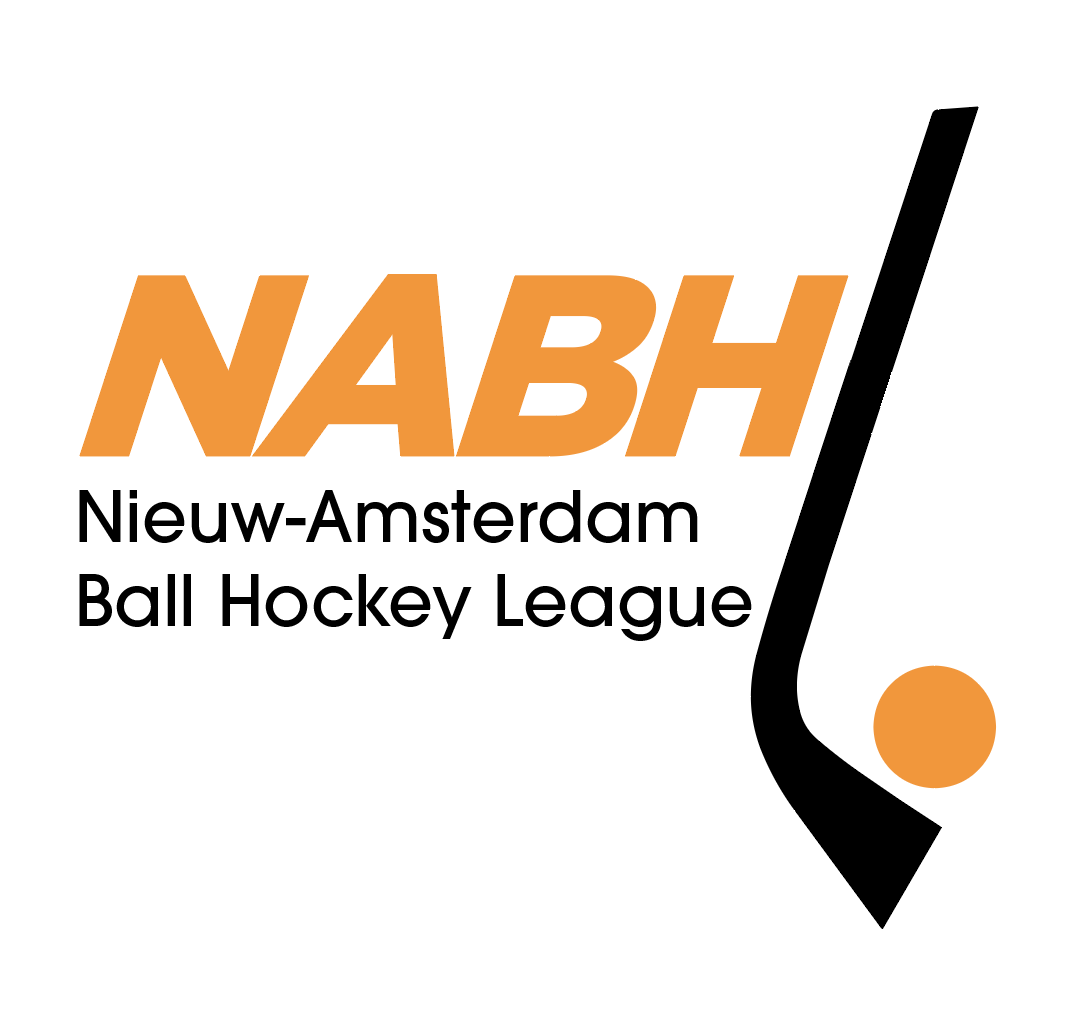

NABHL Rules
All players must be registered and have signed the NABHL waiver form before playing any games. Nieuw since 2021, all players must also be a currently registered member of USA Ball Hockey. Please refer to our registration page for further details.
The NABHL will use a variation of rules from other leagues surrounding and within the greater New York City area, supported by the standards set by USA Ball Hockey. The goal of the league will be competitive and clean hockey.
NEW RULES Spring 2025
PRE-GAME SHOOTOUT
We are no longer having the pre-game shootout.
REGULAR SEASON OT/SHOOTOUT
Since we are no longer having pre-game shootouts, we will now have a post-game shootout if the score is tied after regulation. Shootouts will last 3 rounds by default, and the team that scores the most goals during that the shootout will win the game. If the shootout is tied after 3 rounds, and additional shooter will be selected for each team. This will continue in the same format for up to 7 rounds. If the shootout is still tied after 7 rounds, the game will end in a tie. A unique shooter must be used for every round of the shootout unless the team has gone through all available position players on their roster.
STANDINGS POINTS
1) Three points are awarded to the team winning a game in regulation.
2) Two points are awarded to a team winning a game in a shootout
3) If the match ends in a tie, each team is awarded one point.
4) One point is awarded to a team losing a game in a shootout.
LEAGUE SUBS
Going forward - the following sub policies are now in place;
APPROVED SUBS - any team may use rostered players from another team if the other team approves them. This rule applies in the regular season and playoffs, as captain's may approve players for a team who did not qualify for playoffs (who are otherwise not receiving a league exemption).
UNAPPROVED SUBS - the prior season's 5th place team (fewest points for avoidance of doubt) may use ANY sub that would otherwise not be approved by their opponent, such that the unapproved sub does not put this team at exactly 4 more players than the other team's roster that day. Said another way, this team may use unapproved subs if they were to only have 3 more players on their bench than the other team. This rule only applies in the regular season.
Additionally, any player with a valid USABH ID who is not registered to a team can be used as a sub by any team without approval from the opposing captain. It is worth note that these games will not count toward playoff eligibility, even if that player is added to a roster at a later date.
GOALIES - any goalie may be used in the regular season, they need not be approved and this rule is separate from the above rules related to players on the rink. This rule only applies in the regular season. In the playoffs, the approved sub rule applies to any goalie sub - they must be approved by the opponent (or otherwise have received a league exemption for their playoff eligibility).
Game Length
Games are now three-17 minute running time periods. Same in period timing rules apply. Stop time in the last minute of the first and second periods. Stop time in the last 2 minutes of the third period if there is a 2 goals or less differential in the score (including tie scores).
Preexisting Noteworthy Rules
FIGHTING
Anyone found fighting before, during or after a game will be immediately expelled from the game and league.
CHECKING
Avoidable body contact is not allowed at Dutch Kills. Players must make every reasonable effort to avoid making contact with opponents, especially with a player directly in front of you- you must attempt to go around your opponent. Body contact will be penalized as Roughing or Body Checking as appropriate. Truly incidental contact will not be penalized.
Every player is responsible for being in control of their body and you must play the ball NOT the opponent’s body. Therefore, using your body weight or body (extending an arm/leg/shoulder/hip at an opponent) to dispossess the ball is not a legal play.
Where a roughing penalty is assessed, and the penalty results in an injury to the head (bleeding, etc), this is an automatic major penalty and a game misconduct.
Boarding (hitting from behind into the boards) carries an automatic double minor penalty.
SLASHING
Stick checking is permitted in the sense that these are controlled stick-lifts.
A stick lift that is a wild swing in an upward motion above the cross-bar will be treated as a Non Contact High Sticking Penalty (See “Non Contact Hick Stick Penalty”).
A forceful two handed stick-check on the hands or body of the opponent, and/or 12 o’clock to 6 o’clock and 3 o’clock to 6 o’clock two-handed forceful stick checks applied to anywhere other than an opponent's blade of the stick will be treated as a minor slashing penalty.
(Two handed stick-checks which are not stick lifts should be made blade on blade, not blade/shaft to shaft)
HOOKING
Locking your stick over an opponent's stick shaft and/or body, with the blade tip/toe facing the ground, is a minor hooking penalty.
Locking your stick on the opponents hands, body, or stick shaft, with your stick parallel to the ground, is a minor hooking penalty.
STICK SHIELDING
Stick shielding is legal provided it is not performed with the palm of the glove. Using the palm of the glove to stick shield shall result in a minor penalty for holding the stick.
GAME EJECTIONS AND GAME MISCONDUCT PENALTIES
Any player assessed 3 or more penalties in a game will be ejected from that game.
Non-contact high sticking penalties, carrying/covering the ball penalties (see “Batted Balls”), and equipment related minor penalties, do not count towards the 3 penalties threshold.
Players assessed a game misconduct penalty must leave the playing area and benches immediately. If they do not vacate the premises, their team will forfeit the match. Game misconduct penalties carry with them an additional automatic one game suspension (per USA Ball Hockey rules).
CONTACT HIGH STICK PENALTY
A regular minor or major penalty shall be assessed to any player who makes stick contact with an opponent above the crossbar-level. A major plus a game misconduct penalty shall be assessed to any player who injures an opponent as a result of high sticking. All players must be in control of their stick at all times.
NON CONTACT HIGH STICK PENALTY
Batting the ball OR attempting to play the ball above the height of the crossbar with the stick is unsafe and prohibited. A non contact high sticking penalty will be assessed for anyone playing OR attempting to play the ball with their stick above the height of the crossbar. No goal can be scored as a result of an attacking player playing the ball above the crossbar with the stick and directly entering the goal.
NOTE: Calling for passes and slap shots are legal. Waving your stick at the ball above a cross-bar level height is not.
BATTED BALLS
A player may bat the ball downward, provided they do not close their hand on the ball.
“Carrying” the ball (i.e. closing the hand on the ball and taking a step in any direction) is penalized with a minor penalty. Similarly, batting the ball up twice by the same player is also not allowed and will be penalized with a minor penalty. A player may catch the ball with their feet planted and drop the ball in front of them, but may not make a throwing motion (a catch and throw is also penalized in the same fashion as “Carrying” defined above).
Closing your hand on the ball, while the ball is on the ground, also carries the same “carrying” minor penalty. Doing so in your own crease is penalized with a penalty shot for the opposing team.
PENALTIES
Unless stated above, all other Penalties will be applied following USA Ball Hockey standards.
As games are running time 15 minute periods, all penalties assessed during and which commence during running time will be the following length:
Non Contact High Stick Minor Penalty: 1 minutes
Minor penalties (tripping, holding, body contact, etc): 2 minutes
Double minor penalties (slashing, boarding): 4 minutes (two separate 2 minute minors)
Major penalties: 5 minutes
Misconduct: 10 minutes
Penalties that commence at the start of, or during stoppage time, will be the following length:
Non Contact High Stick Minor Penalty: 1 minute
Minor penalties (tripping, holding, body contact, etc): 2 minutes
Double minor penalties (slashing, boarding): 4 minutes (two separate 2 minute minors)
Major penalties: 5 minutes
Misconduct: 10 minutes
GENERAL PLAYING RULES
REFEREES: The referees have the final say in all calls. Referee abuse will not be tolerated, and is punishable with a minor, major, or game misconduct penalty. If you disagree with a call, please keep your opinions to yourself. Captains may at times during the game, have a constructive conversation with the referee regarding game play.
PLAYERS: All players who are injured during the course of play and have a potential/suspected head injury, including but not limited to, concussions, will be removed from the game at the discretion of the referees. Any player removed from a game must provide written medical clearance to continue playing in the league in future games.
OFFSIDES: When entering the attacking zone the standard USA Ball Hockey rules regarding (touch-up) offsides apply. In line with USA Ball Hockey 3 zone arena/rink rules, once the ball has legally entered the attacking zone, the center line will be the determining line for offsides. Once the ball crosses the entirety of the center line, the blue line will be re-established as the determining line for offsides.
ICING: Will be enforced at a team’s own blue-line. Teams will not be allowed to change on icing calls.
PLAYING TIME: Each game will consist of three periods, 15 minutes in length. The last minute of the first and second period and any overtime periods (playoffs) will be stop time between whistles. The clock will run until the last two minutes of the third period if the games is within 2 goals or less (including tie scores) and at that point become stop time between whistles until the game is no longer within 2 goals, or the game concludes. Teams will each have one 45-second timeout per game.
PLAYING AREA: The net surrounding the court shall be considered in play, provided that a ball striking the protective netting and/or fencing falls directly onto the playing surface.
NET: If the net shall become dislodged during play as is not held on with pegs, but still within reasonable distance from where it originally stood at the beginning of play, a floating goal line shall apply and any ball that enter the net in a legal fashion will stand as a goal. If the referee determines that the net is no longer close to the goal line and continuing play no longer reasonable, play shall be blown dead. A goal shall be awarded if the defending team knocks the net off the goal line as the ball is traveling into the goal.
CREASE: Attackers cannot be in the crease UNLESS the ball is already in the crease.
OVERTIME (OT):
All regular season games which are tied at the end of regulation time (at the end of the third and final period of play) will go to a 3 round shootout. If the shootout remains tied after 3 rounds, it will move to a "sudden death" shootout lasting a maximum of 7 rounds. Each attempt must be taken by a different player excluding goalies if possible. If the shootout remains tied after 7 rounds, the game will end in a tie.
In the playoffs play-in rounds, if a game is tied after regulation, a 5 minute running clock sudden death OT period will be played with 4 players and a goalie per team. The first team to score wins the game.
If a game is tied after the first OT period, a second, 5 minute running clock sudden death OT period will be played with 3 players and a goalie per team. The first team to score wins the game.
If the game is tied after both OT periods, a 3 player shootout will ensue. The home team will have the choice of shooting first or second in the shootout. Teams will defend the same goal they defended in the OT.
If the game is tied after the 3 player shootout, then individual rounds of shootout will ensue until there is a winner. Any player may shoot during the individual shootout "sudden death" rounds until there is a winner.
In the semi-final rounds, if a game is tied after regulation, a 15 minute running clock sudden death OT period will be played with 5 players and a goalie per team. The first team to score wins the game.
If the shootout is tied after the OT period, a 5 player shootout will ensue. The home team will have the choice of shooting first or second in the shootout. Teams will defend the same goal they defended in the OT.
If the game is tied after the 5 player shootout, then individual rounds of shootout will ensue until there is a winner. Any player may shoot during the individual shootout "sudden death" rounds until there is a winner.
NOTE: The championship games will be played with unlimited 15 minute running clock, 5 on 5 sudden death periods until a winner is decided (may revert to prior round playoff format with shootouts pending time constraints).
STANDINGS
1) Three points are awarded to the team winning a game in regulation.
2) Two points are awarded to a team winning a game in a shootout
3) If the match ends in a tie, each team is awarded one point.
4) One point is awarded to a team losing a game in a shootout.
If two or more teams are tied on points, the following tiebreakers will be used in order:
1) Winner of most head-to-head matches between teams tied in the standings
2) Most wins
3) Highest goal differential
4) Least goals against
5) Coin toss, conducted by the league manager
PLAYOFFS
Conducted in a seeding format, where the teams re-seed after each round.
Single game final format: Semi finals and finals if on same day will run with modified OT rules.
The semis will have one period of OT (full 15 minutes, if needed) and then a shootout. OT is 5 on 5. The shootout would be 5 players a team before sudden death. Any player may shoot in sudden death.
The finals will start with one period of OT (full 15 minutes), and time permitting, will continue with a 2nd OT period and so on if needed. OT is 5 on 5. If required same shootout rules as semi finals.
HOME TEAM PRIVILEGES
The home team will use the “Home” bench. Teams begin the game defending the goal nearest to their bench.
Teams will switch sides after each period but not switch benches. This results in a long change in the second period and the first period of overtime (playoff games). There is no penalty for the goalie crossing half without possession of the ball when being pulled for an extra attacker during long change periods.
In a shoot-out (playoff games), the home team decides which team will shoot first.
Should both teams have the same or similar color uniform such that players or officials have difficulty distinguishing them from one another, the away team must wear a different, contrasting colored uniform. Captains are responsible for preparing their teams prior to games so that they’re properly uniformed.
EQUIPMENT
All goalies must wear full goalie equipment including a helmet with full facial protection (full cage), chest protector, blocker, catching glove, protective pants, and leg pads. They are allowed to use all equipment which is allowed by the USA Ball Hockey rules.
Head protection is now required, which is inclusive of a helmet (no visor or cage/fishbowl is required). Upon observing a player not wearing a helmet, the referee will at the next stoppage warn the player and remove the player from the playing surface. If after said warning, a player is on the playing surface without a helmet, or becomes dislodged from said player’s face, the player must either stop playing and put the protective gear back on, or immediately make a change on the fly at their bench (and not be a part of active play during the act of making of said line change). If the player continues playing without a helmet, after a warning is provided to the bench, then a minor penalty will be assessed for an equipment violation.
All players must wear protective gloves which fully cover and protect their fingers and hands. Upon observing a player without protective gloves, the referee will at the next stoppage warn the player and remove the player from the playing surface. The player may not return to the game until they are wearing protective gloves.
All players are allowed to wear any protective equipment which is allowed by the rules of USA Ball Hockey. The use of helmets with cages, shin guards, elbow guards and other protective equipment is encouraged.
The league will use Mylec cold weather balls ("yellow") for games below 30 degrees F.
The league will use Mylec cool weather balls ("pink") for games between 30-50 degrees F.
The league will use Mylec warm weather balls ("orange") for games between 60-75 degrees F.
The league will use Mylec hot weather balls ("red") for games over 75 degrees F.
For games between 50-60 degrees and between 70-75 degrees, captains can decide on the ball of choice for the game. If captains cannot come to a consensus, the choice is deferred to the referees.
MERCY RULE
At any point the score is an 8 goal margin, the game will be called final as the score current stands.
The game will also be called final via mercy if the trailing team, who started with more than 5 players and a goalie to start the game, do not have enough players to serve a penalty at any juncture of the game, and/or no longer have 5 players and a goalie eligible to continue play (following the end of the first period - please see forfeiture rules below).
FORFEIT RULE
A team may start a game with 4 players and a goalie (5 total), or 5 total players and no goalie (5 total), provided they take their timeout to wait for a 6th player. If no 6th player arrives during the timeout, the team will be assessed a delay of game bench minor penalty. If no 6th players arrives by the end of the first period, the game is forfeited.
The game will be called final and forfeited by leading team, who started with more than 5 players and a goalie to start the game, do not have enough players to serve a penalty at any juncture of the game, and/or no longer have 5 players and a goalie eligible to continue play.
Forfeits will be scored 8-0.

